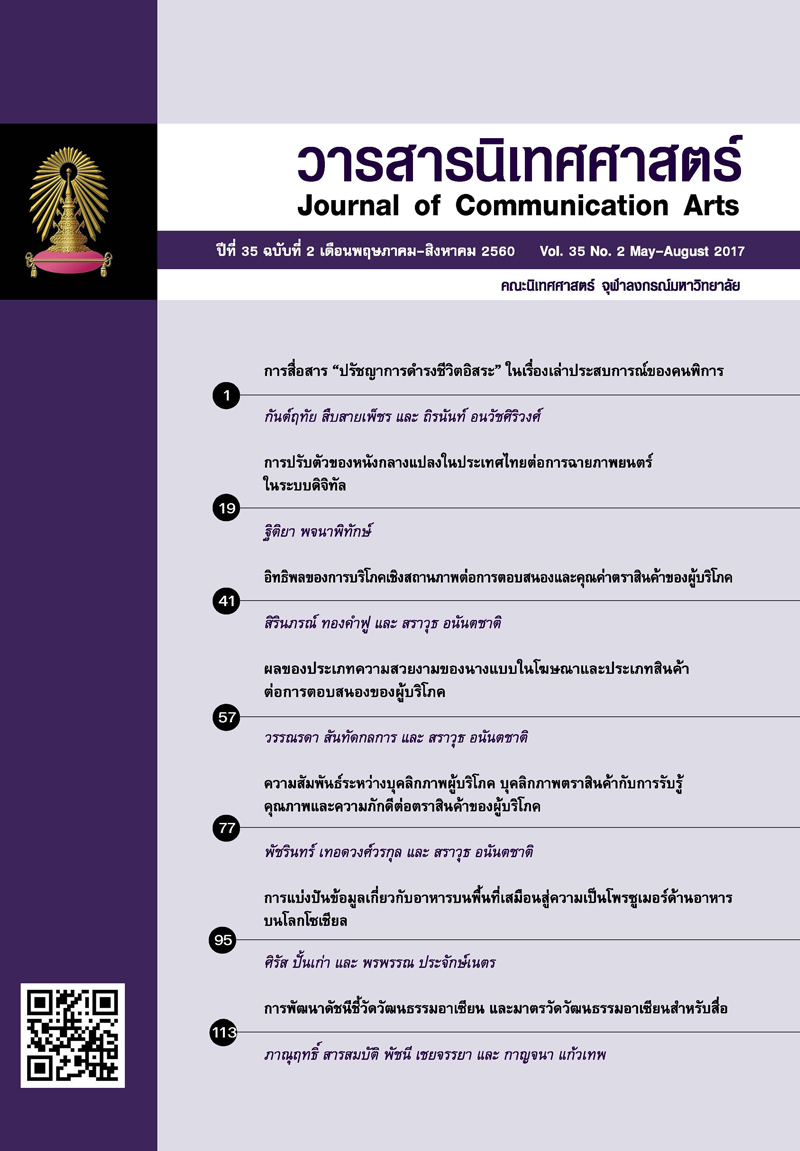The Adaptation of the Thai Outdoor Cinema towards the Digital Cinema System
Main Article Content
Abstract
“The Adaptation of the Thai Outdoor Cinema towards the Digital Cinema System” was aimed at studying the impacts of the transition in technology from negative film exhibition to digital cinema exhibition on the outdoor cinema as well as the responsive adaptations. A combination of purposive sampling and snowball sampling was used in this qualitative research. The sample consisted of a number of outdoor cinema exhibitors representing the four regions of local film exhibitors in Thailand and people involved in the outdoor cinema. This research was aimed at analyzing the obtained information and suggesting some guidelines to promote the outdoor cinema.
It was found in the study that the impacts on the local outdoor cinema exhibitors caused by the change of film projection system include 1) the unavailability of film for projection, 2) the potential inconvenience caused by an investment on an up-to-date film exhibition system, and 3) the audience’s changed feelings towards the original screening system. As a result, the government is obliged to pass opinions, policies and regulations in response to the impacts on the outdoor cinema so as to satisfy the needs of 1) counseling services providing substantial knowledge on how to comply with motion picture laws and copyright laws step by step, and 2) the government’s guidelines and policies that support the outdoor cinema.
The responsive adaptations of the outdoor cinema in Thailand are as follows: 1) Some outdoor cinema exhibitors are using digital equipment to exhibit films from motion picture files that infringe on copyright; 2) Some regional film distributors are letting motion picture media whose copyrights have been assigned by the film production companies; and 3) Outdoor cinema exhibition has become a part-time job or a hobby for some film exhibitors. However, having a number of old film negatives available for renting and seeing that changing the film projection system would not be cost-effective compared to the current service requests, some exhibitors are not adapting to the change but continuing their conservative practices of negative film exhibition.
The guidelines for the promotion of outdoor cinemas suggest that: film production companies, film distributors and film exhibitors together form a policy that allows outdoor cinemas to exhibit films digitally; public sector provide film exhibitors with substantial knowledge on motion picture laws and copyright laws and promote outdoor film exhibition as a form of cultural entertainment; and private sector and any organizations take part in preserving the outdoor cinema by including an outdoor film exhibition in their special events.
Article Details
References
กำจร หลุยยะพงศ์. (2558). กฎหมายและจริยธรรมที่เกี่ยวข้องกับการบริหารงานภาพยนตร์ เอกสารการสอนชุดวิชาการบริหารงานภาพยนตร์ หน่วยที่ 11. นนทบุรี: สำนักพิมพ์มหาวิทยาลัยสุโขทัยธรรมาธิราช.
ชญานิน ธนะสุขถาวร. (2554). ผลกระทบจากการขยายกิจการโรงภาพยนตร์มัลติเพล็กซ์ต่อระบบสายหนังในประเทศไทย. (วิทยานิพนธ์นิเทศศาสตรมหาบัณฑิต), คณะนิเทศศาสตร์ จุฬาลงกรณ์มหาวิทยาลัย.
ชัยวัฒน์ ทวีวงศ์แสงทอง และสุมน อยู่สิน. (2558). การบริหารงานเผยแพร่และจัดจำหน่ายภาพยนตร์ เอกสารการสอนชุดวิชาการบริหารงานภาพยนตร์ หน่วยที่ 6 มหาวิทยาลัยสุโขทัยธรรมาธิราช. นนทบุรี: สำนักพิมพ์มหาวิทยาลัยสุโขทัยธรรมาธิราช.
ชาญชัย อัตถาหาญ. (2559, 23 ตุลาคม) สัมภาษณ์โดย: ฐิติยา พจนาพิทักษ์. หน่วยบริการหนังกลางแปลงชาญชัยภาพยนตร์, จันทบุรี.
ฐานเศรษฐกิจ. (2554). เมเจอร์-เอสเอฟ แข่งทุ่มทุนเปลี่ยนเทคโนโลยี สู้ศึกโรงหนังดิจิทัล. สืบค้นจาก http://www.icons.co.th/newsdetail.asplang=EN&page=newsdetail&newsno=28390
ดนุวัฒน์ เจตนา. (2553). การวิเคราะห์แนวโน้มการเปลี่ยนแปลงการถ่ายทำภาพยนตร์ระบบฟิล์มเป็นระบบดิจิทัลในประเทศไทย. (วิทยานิพนธ์นิเทศศาสตรมหาบัณฑิต), คณะนิเทศศาสตร์ จุฬาลงกรณ์มหาวิทยาลัย.
ธนาทิพ ฉัตรภูติ. (2547). ตำนานโรงหนัง. กรุงเทพฯ: สำนักพิมพ์เวลาดี.
นพดล อินทร์จันทร์. (2554). ภาพยนตร์ไทยพัฒนาการความคิดด้านศิลปวัฒนธรรมในสังคมไทย ภาพยนตร์และละครโทรทัศน์ไทย. กรุงเทพฯ: โรงพิมพ์มหาวิทยาลัยศรีนครินทรวิโรฒ.
ประดิษฐ์ โปซิว. (2559, 27 พฤษภาคม) สัมภาษณ์โดย: ฐิติยา พจนาพิทักษ์. ผู้อำนวยการสำนักภาพยนตร์และวีดิทัศน์, กรุงเทพฯ.
ปัทมวดี จารุวร. (2550). สื่อสารมวลชนเบื้องต้น (พิมพ์ครั้งที่ 2). กรุงเทพฯ: สำนักพิมพ์แห่งจุฬาลงกรณ์มหาวิทยาลัย.
ผู้จัดการออนไลน์. (2557). Paramount เลิกฉายฟิล์มยกเว้นหนัง"คริสโตเฟอร์ โนแลน". สืบค้นจาก http://www.manager.co.th/Entertainment/ViewNews.aspx?NewsID=9570000011533
มนัส กิ่งจันทร์. (2545). หนังเร่ เส้นเลือดฝอยของหนังไทย. บันทึกหนังไทย 2543-2544 วารสารเฉพาะกิจสมาคมสมาพันธ์ภาพยนตร์แห่งชาติ. 44-45.
มหาวิทยาลัยบูรพา. (2557). ทฤษฎีการเปลี่ยนแปลงทางสังคม. สืบค้นจาก http://www.huso.buu.ac.th
/cai/Sociology/225101/Lesson13/ทฤษฎีการเปลี่ยนแปลงทางสังคม.htm
วิวัฒน์ ยุกตเวทย์. (2558, 9 กรกฎาคม) สัมภาษณ์โดย: ฐิติยา พจนาพิทักษ์. หน่วยบริการหนังกลางแปลงภาคิณภาพยนตร์, เชียงใหม่.
สำนักงานคณะกรรมการกฤษฎีกา. (2557). พระราชบัญญัติภาพยนตร์และวีดิทัศน์ พ.ศ. 2551. สืบค้นจาก http://web.krisdika.go.th/data/law/law2/%C008/%C008-20-2551-a0001.pdf
สื่อสร้างสุขอุบลราชธานี. (2556, 24 พฤษภาคม). จุดสิ้นสุดฟิล์มภาพยนตร์ [รายการโทรทัศน์ที่นี่บ้านเรา ตอนเสียงในฟิล์ม]. กรุงเทพฯ: สถานีโทรทัศน์ไทยพีบีเอส.
สุทิน หวังไพบูลย์. (2559, 29 พฤษภาคม) สัมภาษณ์โดย: ฐิติยา พจนาพิทักษ์. หน่วยบริการหนังกลางแปลงท่าพระภาพยนตร์, กรุงเทพฯ.
สุภางค์ จันทวานิช. (2559). ทฤษฎีสังคมวิทยา (พิมพ์ครั้งที่ 7). กรุงเทพฯ: สำนักพิมพ์แห่งจุฬาลงกรณ์มหาวิทยาลัย.
สุริชัย หวันแก้ว. (2553). สังคมและวัฒนธรรม. กรุงเทพฯ: สำนักพิมพ์แห่งจุฬาลงกรณ์มหาวิทยาลัย.
ภาษาอังกฤษ
Anton S. & Bryn P. (1993). Successful Event Management – A Practical Handbook. London: Thomson Learning.


